1. 引言
功能梯度材料(FGM)是一种可设计的新型复合材料,其材料特性在特定方向上平滑连续变化。FGM在热环境中工作时,可以避免因温度的变化导致应力集中甚至结构失稳的发生。目前为止,已有大量关于FGM结构稳定性的研究论文发表,但大多仅限于弹性稳定性方面。例如,文献 [1] 和文献 [2] 采用有限元法分别研究了FGM板和FGM圆柱壳的弹性屈曲。文献 [3] [4] [5] 采用打靶法等分别研究了FGM圆板、环板和梁的弹性热屈曲、动态屈曲及后屈曲。文献 [6] [7] 运用了摄动法研究了弹性FGM圆柱壳的热后屈曲和FGM板的后屈曲。文献 [8] 研究了FGM梁的热屈曲问题,求得临界屈曲温度。
以上关于FGM结构屈曲的研究尚局限于弹性范围内。若结构厚度尺寸较大,内部应力也较大,同时由于作为FGM重要组分的金属是塑性材料,它的存在极易使结构在应力较大的区域产生塑性变形,发生弹塑性屈曲。目前有少量关于FGM结构弹塑性屈曲的研究成果,文献 [9] 用有限元法研究了受机械载荷作用的FGM梁的弹塑性屈曲。文献 [10] 用辛方法研究了轴压FGM欧拉梁的弹塑性屈曲,发现只有当幂律指数大于一定值时,才会发生弹塑性屈曲。文献 [11] 用GDQ法研究了FGM矩形板的弹塑性屈曲,发现板越厚,形变理论和增量理论的差异就越大。文献 [12] 研究了FGM板的弹塑性屈曲和后屈曲,发现弹塑性屈曲临界载荷比弹性屈曲临界载荷小得多。文献 [13] 研究了FGM杆的扭转弹塑性屈曲,发现塑性区域随着幂律指数的增加而更快地扩大。文献 [14] 研究了轴压FGM圆柱壳的弹塑性屈曲,发现随着体积分数的增加,临界载荷急剧下降。在此基础上,文献 [15] 加入了径向压力,研究了径压轴压共同作用下FGM圆柱壳的弹塑性屈曲,发现了材料的塑性流动对稳定区有显著影响。
研究FGM结构的弹塑性屈曲可更精确地预测临界载荷,从而更好地发挥材料的塑性性能。目前尚未见考虑温度依赖性的剪切可变形FGM梁的弹塑性屈曲的研究成果。因此本文考虑FGM物性参数的温度依赖性,研究FGM Timoshenko梁的弹塑性屈曲。在Hamilton体系下求解控制方程,并进行数值算例分析获得FGM梁的临界载荷和塑性变形域及其影响因素。
2. 控制方程及求解
考虑厚度方向梯度变化的矩形截面FGM梁,长为l、宽为b、高为h。在梁的几何中面上建立坐标系
,原点O位于梁的左端横截面的中心,x轴沿轴向,该向位移记为u,几何中面上为
;y轴沿宽度方向;z轴沿厚度方向,横向挠度记为w,几何中面上为
;横截面的转角记为
。弹塑性交界面为s,如图1所示。研究FGM梁在变温环境中的屈曲问题。

Figure 1. Functionally graded Timoshenko beam
图1. 功能梯度Timoshenko梁
2.1. 等效物性参数
FGM考虑由陶瓷和金属两相材料制成,且假设其体积分数
和
沿厚度方向以幂函数形式连续变化:
,
(1)
其中
为体积分数指数,不同值代表了成分含量不同的功能梯度材料。
时退化为纯陶瓷梁;
时则为纯金属梁。对处于变温环境中的FGM梁,其材料的物性参数考虑与温度的相关性:
(2)
其中P泛指金属和陶瓷的弹性模量、切线模量和屈曲极限;j为c或m,分别代表陶瓷和金属;T为绝对温度;
、
、
、
、
为材料的温度相关系数。弹塑性FGM的弹性模量E、切线模量H和屈服极限
基于TTO模型给出:
,
,
(3)
其中
、
和
为金属的弹性模量、切线模量和屈曲极限;
为陶瓷的弹性模量。剪切弹性模量为
。泊松比
随温度变化不大,一般取为常数 [16]。
2.2. 基本方程和边界条件
FGM梁的正应变
和切应变
基于Timoshenko梁理论建立:
,
(4)
FGM的本构关系基于线性强化弹塑性模型建立,正应力
和切应力分别为 [16]:
(5a)
(5b)
上式中
为温度增量,一般初始温度
;
为热膨胀系数,由线性混合律模型 [10] 计算;s为FGM梁的弹塑性分界面到几何中面的距离,
。若
,发生弹性屈曲;
,发生塑性屈曲;
,则发生弹塑性屈曲。本文考虑固定(C)和不可移简支(S)两种边界约束,边界条件分别为:
,
.
2.3. 正则方程
本文利用Hamilton体系下的辛方法研究FGM梁的弹塑性屈曲。为了引入Hamilton体系,定义
、
和
、
,FGM梁的Lagrange密度函数可表示为:
(6)
其中:Q为轴向压缩荷载,
为动能密度,
为应变能密度,
为势能密度,
为FGM梁的单位面积的质量。
和
为FGM梁的刚度系数,
为剪切刚度系数。进行量纲为一的处理,
,
,
,
,
,
,
,
,将原变量记为
,
并引入对偶
,得到
和
,则系统的Hamilton函数表示为:
(7)
通过变分运算可得FGM梁在Hamilton系统下的对偶正则方程:
(8)
2.4. 方程的解析解
在辛空间中,FGM梁屈曲时满足条件
,可得方程:
(9a)
(9b)
联立求解以上方程组可得到FGM梁屈曲的挠度通解为:
(10)
其中
,待定系数
、
、
和
由边界条件确定,本文考虑两种边界条件梁,分别是两
端固定(C-C)和一端固定一端不可移简支(C-S)。把两种边界条件分别代入到通解式(10)中得线性方程组,并化简可得分叉条件,C-C边界为:
(11a)
C-S边界为:
(11b)
分别求解方程(11a)和(11b)得到无量纲屈曲特征值
。C-C边界的
为39.47,80.76,157.91,238.72,……;C-S边界的
为20.19,59.67,118.90,197.85,……。考虑边界条件、并同时利用归一化方法令
,可得以上特征值对应的第i阶的弹塑性屈曲模态,C-C边界为:
(12a)
C-S边界为:
(12b)
FGM梁发生弹塑性屈曲,为了求解弹塑性变形的分界面到中面的距离
,可利用屈服条件
。将特征值
依次回代,并通过数值解方程,可以得到临界屈曲载荷N和弹塑性交界面s。
3. 数值算例和讨论
本节将给出以上理论推导的数值算例。梁的长度取为
,长细比分别选
和
。组分材料选为陶瓷ZrO2和金属Ti-6Al-4V,两种材料的温度相关系数可见文献 [16] [17]。
3.1. 临界屈曲载荷
图2绘出了长细比
时两种边界条件FGM梁的临界载荷随材料体积分数指数n的变化关系曲线。由图可见当幂指数n和环境温差增大时,FGM梁的临界载荷会逐渐减小,即FGM梁在热环境中的承受能力也逐渐减小。是因为随着幂指数n的增大,金属含量增大,FGM梁的弹性模量和抗弯刚度减小。而且对于两种边界条件下较小的n,即
和
时,无临界载荷,这是由于FGM梁中的陶瓷含量高而构件不发生弹塑性屈曲失效。当
和
时,FGM梁开始发生弹塑性屈曲。另外,环境温度越高临界载荷越小,若FGM梁的环境温度增加60K时,临界载荷的差值可达5%,这是由于材料在高温环境中的弹性模量和屈服强度降低,导致FGM梁的承载能力随即降低,计算发现当温差大于150 K时梁无弹塑性屈曲发生。
 (a) C-C边界(Clamped-Clamped boundary)
(a) C-C边界(Clamped-Clamped boundary) 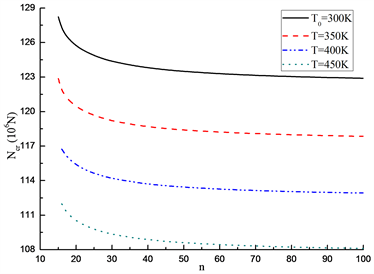 (b) C-S边界(Clamped-Simply supported boundary)
(b) C-S边界(Clamped-Simply supported boundary)
Figure 2. Effect of volume fraction index n on critical load
(
)
图2. 体积分数指数n对临界载荷
的影响(
)
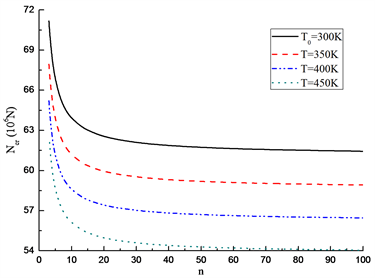 (a) C-C边界(Clamped-Clamped boundary condition)
(a) C-C边界(Clamped-Clamped boundary condition) 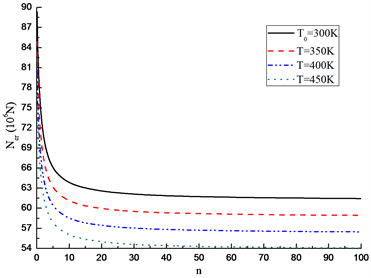 (b) C-S边界(Clamped-Simply supported boundary)
(b) C-S边界(Clamped-Simply supported boundary)
Figure 3. Effect of volume fraction index n on critical load
(
)
图3. 体积分数指数n对临界载荷
的影响(
)
图3绘出了长细比
时两种边界条件FGM梁的临界轴向载荷随材料体积分数指数n的变化关系,与图2对比可见
时的临界载荷大于
时的,显然长细比对临界载荷的影响较大。
3.2. 屈服界面
图4绘出了两种边界FGM梁的弹塑性分界面到中面的距离s随体积分数n的变化曲线。由图可见,当幂指数n增加时,FGM梁的弹塑性分界面的距离会逐渐增大,即逐渐远离陶瓷侧。即FGM梁发生弹塑性屈曲时,屈服界面随n的增大由陶瓷侧逐渐移向金属侧。这是由于当n增大,即金属的成分增大,FGM梁的塑性流动域逐渐减大。同时可见,当n较大时,环境温度的变化对弹塑性分界面的影响较明显。因为n较大时,FGM梁内的金属成分很大,金属的力学性能受温度的影响比陶瓷大,因此n越大,温度效应越明显。且温度越高屈服界面越靠近金属侧,塑性流动区域越大。
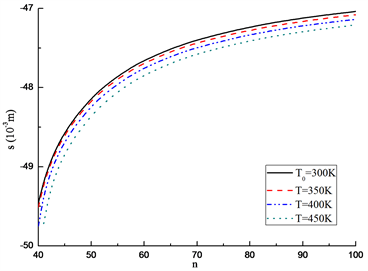 (a) C-C边界(Clamped-Clamped boundary condition)
(a) C-C边界(Clamped-Clamped boundary condition) 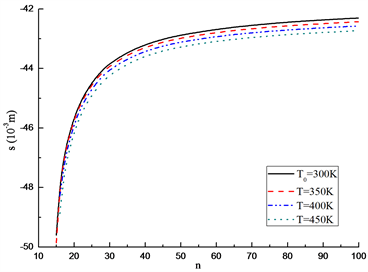 (b) C-S边界(Clamped-Simply supported boundary)
(b) C-S边界(Clamped-Simply supported boundary)
Figure 4. Effect of volume fraction index n on elastoplastic interface s (
)
图4. 体积分数指数n对弹塑性交界面s的影响(
)
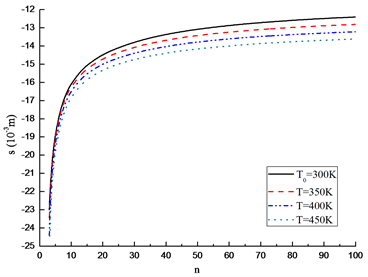 (a) C-C边界(Clamped-Clamped boundary condition)
(a) C-C边界(Clamped-Clamped boundary condition)  (b) C-S边界(Clamped-Simply supported boundary)
(b) C-S边界(Clamped-Simply supported boundary)
Figure 5. Effect of volume fraction index n on elastoplastic interface s (
)
图5. 体积分数指数n对弹塑性交界面s的影响(
)
图5绘出了长细比
时两种边界FGM梁发生弹塑性屈曲时弹塑性界面到中面的距离s随体积分数n的变化规律曲线。特别地,对于C-S边界条件,当
时,弹塑性分界面的距离为非单调变化,这是因为梁中金属的成分增加导致临界轴力快速减小,屈服界面向陶瓷侧移动,致使FGM梁内的塑性流动区域反而减小。
4. 结论
1) 基于Timoshenko剪切变形理论和辛方法研究了FGM梁的弹塑性屈曲,建立了Hamilton体系中的屈曲模态方程和分叉条件,通过解析求解获得了屈曲载荷和屈曲模态,同时也得到了弹塑性分界面。
2) 临界载荷随体积分数指数、环境温度和长细比的增大而减小。
3) FGM梁弹塑性屈曲时的塑性流动域受到梯度参数、长细比和边界条件的影响。对于较小长细比的FGM梁,弹塑性屈曲时屈服界面靠近陶瓷侧,塑性流动区较大;对于较大长细比的FGM梁,屈服界面更偏向金属侧,塑性流动区较小。
NOTES
*通讯作者。